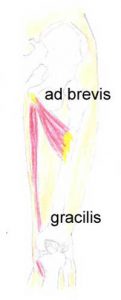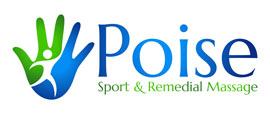The adductor muscles are sometimes more commonly known as your groin muscles because of their location. We might think of there only being one muscle, but actually there are 5 in the group that collectively are known as adductor muscles:
- Adductor Magnus
- Gracilis
- Adductor Longus
- Pectineus
- Adductor Brevis
The muscles are all located in your lower pelvis and attach to various points of the femur and tibia leg bones. Together, they do exactly what their name implies, they adduct the hip – think of moving your straight leg out to the side. They also act to stabilize the hip. The adductor magnus is the largest and strongest muscle of the group, whilst the gracillis is the only muscle of the group to cross 2 joints – the hip and knee joints.
Where are they?

Adductor magnus: The origin is inferior ramus of the pubix, ramus of the ischium and ischial tuberosity of the pelvis. The insertion is the medial lip of the linea aspera and adductor tubercle of the femur.

Adductor longus: The origin is the pubic tubercle of the pelvis. The insertion is the medial lip of the linea aspera of the femur.
Pectineus: The origin is the superior ramus of the pubis of the pelvis. The insertion is the pectineal line of the femur.

Adductor brevis: The origin is the inferior ramus of the pubis of the pelvis. The insertion is the pectineal line and medial lip of the linea aspera of the femur.
Gracilis: The origin is the inferior ramus of the pubis of the pelvis. The insertion is the proximal, medial shaft of the tibia.
What do the adductors do?
All the muscles in the adductor group adduct and medially rotate the hip.
With the exception of the gracillis, all the muscles help to flex the hip.
Because the gracilis crosses 2 joints (the hip and knee), it also flexes and medially rotates the knee (the latter when the knee is flexed).
The posterior fibres of the adductor magnus also extends the hip.
Common problems and injuries
When we see sports men or women suddenly go down in pain gripping the inside of their legs, the commentator may immediately identify the problem as groin strain. But it can happen to any of us. It usually happens when the legs slide apart suddenly and further than the muscles can cope with. Men can be more prone to this than women.
Groin injuries can be acute and difficult to diagnose (there are 5 muscles in the group after all) and can result in chronic pain. Overuse is the most common type of injury, or as a result of a hernia. Although healing can be quite kick, 1-2 weeks, recovery can take up to 5 months. Consequently, rest is very important and making sure that there is no pain before doing any movements under load.
If you are doing any activities or exercises that involve side lunges or kicks, it is good to make sure you have warmed up sufficiently before doing them.
Stretches and rehabilitation
Start these 2 exercises with the side that needs to be stretched first before repeating on your stronger side to maintain balance.
- A good stretch for adductors is the simple sideways lunge. Stand with your legs apart and upper body straight. Lean to the unaffected side so that your knee bends, whilst the adductor on the other leg is stretched as the leg remains straight. You should feel the stretch. Hold for 20 seconds and repeat 5-6 times.
- To strengthen the adductors lie on your side with the adductor your are wishing to strengthen nearest the floor. Support yourself on your side with your arms and keep the leg on the floor straight as you bend the top most leg so you foot is flat on the floor behind your straight leg. Slowly lift your straight let about 15cm off the floor and hold for 5 seconds before slowly lowering back to the floor. Repeat for 5 times.
Revised 29/5/19
